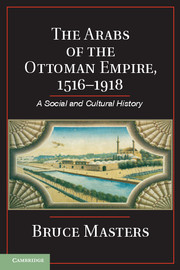Book contents
- Frontmatter
- Contents
- Acknowledgments
- Abbreviations
- Note on Transliteration
- Introduction
- 1 The Establishment and Survival of Ottoman Rule in the Arab Lands, 1516–1798
- 2 Institutions of Ottoman Rule
- 3 Economy and Society in the Early Modern Era
- 4 A World of Scholars and Saints
- 5 The Empire at War
- 6 The Tanzimat and the Time of Re-Ottomanization
- 7 The End of the Relationship
- Conclusion For the Faith and State
- Bibliography
- Index
- References
6 - The Tanzimat and the Time of Re-Ottomanization
Published online by Cambridge University Press: 05 April 2013
- Frontmatter
- Contents
- Acknowledgments
- Abbreviations
- Note on Transliteration
- Introduction
- 1 The Establishment and Survival of Ottoman Rule in the Arab Lands, 1516–1798
- 2 Institutions of Ottoman Rule
- 3 Economy and Society in the Early Modern Era
- 4 A World of Scholars and Saints
- 5 The Empire at War
- 6 The Tanzimat and the Time of Re-Ottomanization
- 7 The End of the Relationship
- Conclusion For the Faith and State
- Bibliography
- Index
- References
Summary
When Sultan Abdülmecid I (1839–61) issued his “noble decree” (Hatt-ı Şerif) at Gülhane Park in Istanbul on 3 November 1839, its preamble made it clear that reform was necessary to restore the empire to the halcyon days of its past. The surface message was that that he did not seek to impose on his subjects anything that was new. Imbedded in the call to a restoration of what had been, however, were hints of a future that would see radical breaks with that past. These included the end of tax farming, a call for universal male conscription, and the rather vague sentence “the Muslim and non-Muslim subjects of our lofty Sultanate shall, without exception, enjoy our imperial concessions.” Historians of the Ottoman Empire have debated how to characterize the series of initiatives that were undertaken between 1839 and 1876, which were known in Ottoman Turkish as the Tanzimat (Reordering). Because the terms “Westernization” and “modernization” have fallen out of favor for some, a consensus has lately emerged that “the age of reform” is the appropriate, nonjudgmental designation for the period.
The questions of the reform of what exactly and to what ends have not produced any agreement among historians, however. Şükrü Hanioğlu has argued that the framers only inserted the language of the preamble in a final draft of the proclamation to appease potential critics of the initiative among the ulama. In his interpretation, the reformers did indeed seek to “modernize” the empire, following Western models. Hanioğlu thus situates himself within the Turkish republican historiographical tradition, which interprets the Tanzimat as having been both self-consciously “modernizing” and “Westernizing,” initiating a process that would ultimately result in the proclamation of the Turkish Republic in 1923.
- Type
- Chapter
- Information
- The Arabs of the Ottoman Empire, 1516–1918A Social and Cultural History, pp. 157 - 191Publisher: Cambridge University PressPrint publication year: 2013



